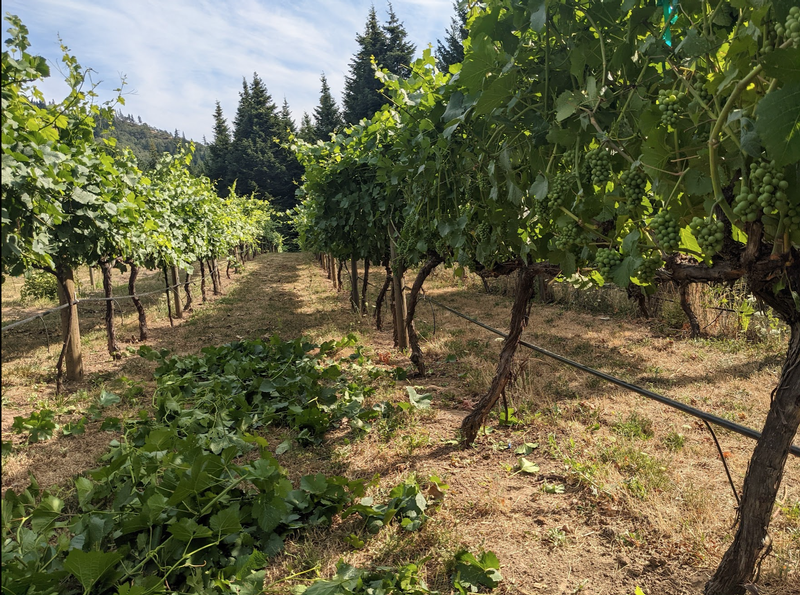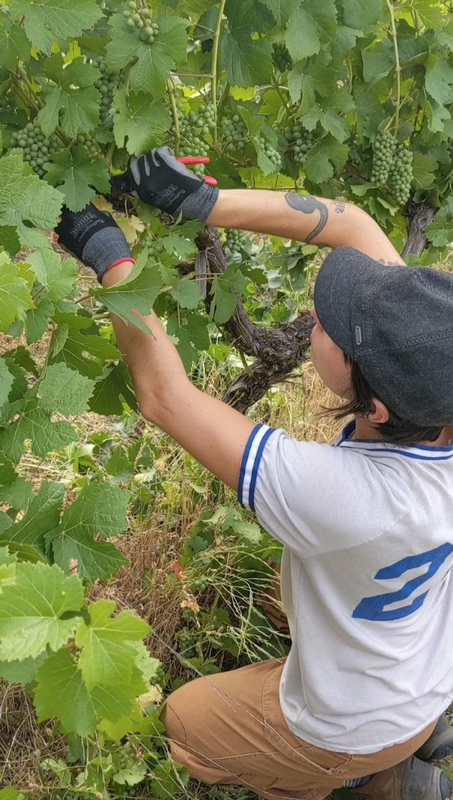All about Canopy Mangement
In the last post, I described the many vineyard tasks in the Spring such as pruning, tying and trellising. As the vines start to grow and the long summer days kick in, Alexis has stressed the importance of the next task at hand: Canopy Managment. This is what I've learned so far:
Canopy definition
The canopy of a grapevine is defined as the collective parts of the grapevine's fruit, trunk, shoots, cordons and leaves. So technically, when we covered pruning and tying down canes, that was canopy management too--albeit early stages.

The real guts of the actual managing of the canopy happen once the vine starts to grow--shoots, leaves, suckers, fruit everywhere!
Purpose of canopy mangement
The goal of managing the vineyard canopy is to bring forth the best possible grapes to be grown. During the summer, the grapes undergo a critical growth phase in their life--the build up before harvest in the fall.
Left to their own will, vines will grow all over the place; into the rows, over the trellising wire, hang to the ground, shade the fruit etc.. but there are things one can do to improve the quality of the fruit.
How to effectively manage the canopy

Follow these tips for effective canopy management. Style will differ with every vigneron, but this is what we've observed and learned so far:
- Generate airflow: Airflow through the vine's canopy is key. It will reduce the amount of disease pressure like mildew and bunch rot, requiring less spraying.
- Tucking: this may vary depending on the training and trellising style, but for VSP (vertical shoot positioning), you want the vine's shoots to grow upwards. In order to influence the vine to do so, you'll need to tuck the wild shoots into the trellising wire. This will not only help with airflow, but also allow more sunlight to reach the leaves for photosynthesis.
- Thinning: Too much fruit actually may not be a good thing. Balance is key in the vineyard and the vine's limited energy is stretched too thin by too many clusters on the vine, the end result won't be favorable. So the remedy is to thin (also known as dropping fruit). Another aspect of thinning is to get rid of any suckers and water shoots that didn't bloom any fruit.
- Leafing: Similar to abundant fruit, too many leaves can be a problem as well. Leaves are important to the life of the vine as they receive energy via photosynthesis. However, too much can block airlfow leading to higher disease pressure and provide too much shading to the fruit and
- Exposing the fruiting zone: Grapes need sunlight to ripen. If they are covered in shade by leaves, they're going to have a bad time. Thus, getting rid of the leaves in the fruiting zone will enable the grapes to have more sunlight exposure, help with airflow and also allow for anti-mildew spray to reach the grapes more easily.
- Deer Decoy: If the vineyard is not fenced properly, it may fall under attack from free roaming deer. Deer don't necessarily eat the fruit but they will munch on the leaves. By keeping a few leaves around the fruiting zone, it will allow some margin for the deer to consume their leaves without negatively impacting the plant.
Key takeaways for Canopy Management
Domaine Pouillon stresses balance in the vineyard. Too much thinning and leafing will lead to a malnourished vine. In contrast, a vine that has too many fruit clusters and leaves will have a tough time reaching full ripening and maturation.
There are many choices to make during this critical phase. Choose wisely, and the vine will be set up for success as we barrel toward veraison and harvest.
Comments
Commenting has been turned off.stay in the know
Sign Up For Our Newsletter
Keep up to date on the latest wine releases, events, and promotions and get 10% off your next order.